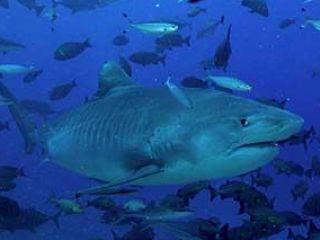"Over 19 years making dreams come true for divers... just like you"
Contact us now at ask@dive-the-world.com
Tiger shark Newsletter
Tiger sharks... they're grrreat!
Named for their stripes reminiscent of the fearsome jungle predator, tiger sharks have the title of second deadliest shark in our oceans. Yet for all the media hype, over the past 400 years or so there are only around 30 fatalities on record. You literally have more chance of being struck by lightning!
If they are so scary why do divers actively seek out encounters with tigers? Where will you be able to have an exhilarating tiger shark dive? What is unique about tigers? You’ll be surprised to hear what they have been known to eat….Read on to find out more about these fearsome predators.
Fact Sheet
Family name: Carcharhinidae (requiem sharks)
Order name: Carcharhiniformes
Sub-order: Elasmobranchii (sharks and rays)
Common name: Tiger shark
Scientific name: Galeocerdo cuvier
Distinguishing Features

The tiger shark’s dark stripes are present on the juveniles, but these fade as the shark matures. Tigers longer than 3m may not even display the stripes characteristic of their name. Their rough, thick skin is blueish-green to dark grey on top, and a yellowish white on the underbelly.
Their mouth has been compared to a circular saw, with their very sharp, short serrated teeth that have a sideways pointing tip. Like many of their cousins, their teeth are continually replaced as needed throughout their lifespan. They have pronounced nostrils and low-light sensing eyes, providing them with an excellent sense of smell and sight.
Female tigers are on average 20% larger than their male counterparts. The largest female came in at over 5m, with the largest male measuring 4m. The average tiger will be about 3.25-4.25m long and weighs around 385-635 kg, coming in behind the whale shark, basking shark and great white in terms of size.
Behaviour
Tigers generally move slowly, using their pectoral and caudal (tail) fins for propulsion and their dorsal fins to change direction. Don’t let their sluggish speed fool you, they are known to be one of the strongest swimmers among their kind. They use their vibration detectors (located along their sides) to help detect movement in the water. With their large stomachs and voracious appetites, a large portion of the tigers’ activities is focused on eating. This may be through hunting or scavenging. Scientists are divided if tiger sharks do in fact prefer warmer waters or if they are merely following their prey; they have been recorded to migrate to Hawaii each June to hunt albatross.
They are predominantly a solitary species, except when there is abundant food or for procreation. In the northern hemisphere this occurs from March to May, and the southern hemisphere mating happens from November to January.
Feeding Habits
They do not have a discerning palate which may account for the higher number of human fatalities. Unlike great whites who will release prey when they realise that the meal is not what they expected, tigers keep consuming. However, the numbers of human attacks are low. They do not have the speed of the mako, or the shock surprise of great whites. They rely on persistence and their incredible power when hunting.
Tigers possibly have the most diverse diet out of all the sharks, which has earned them the nickname ‘garbage can of the sea’. Their more unusual dining extends to birds, bats, porcupines, man-made products such as trash and even condoms.
The more expected tiger shark menu includes shallower water inhabitants such as a variety of small fish, sea snakes, octopuses and a variety of other molluscs. As the predators grow in size, so do their prey. More mature tigers have been known to prey on oceanic mantas, 20 different species of sharks, 18 different rays, turtles, dolphins, dugongs, seals and a healthy variety of deep-sea fish.
Reproduction

Tiger sharks mature slowly and their sexual maturity is determined by their length: 2.5-3.5m for females and 2.25-2.90m for males. Mating is not a romantic affair amongst tigers. The male bites the female on her back to keep her in place while he inserts one of his claspers into her oviduct and releases sperm. This frequently leaves extensive scars on the females. Once mating has occurred, the sperm can be stored for 4-5 months before the eggs are fertilised.
After fertilisation, the pups will hatch and grow inside the female’s womb where they receive oxygen. There is no placenta and they feed from the unfertilised egg yolks. After about 15-16 months gestation, the pups are born live and measure 80-90 cm. Estimates of litter size vary from 10-80.
Life Cycle
Tiger shark pups are born live and have a full complement of teeth. They are not nurtured by their mother and immediately have to fend for themselves. Their natural colouration (their dark stripes and spots) may give them some protection by helping them to blend in with the waves close to the coast. It offers them little in the way of protection when even their larger family members have been known to snack on them. They are slow to mature and can be vulnerable during this phase of their lives. Once they reach maturity, tiger sharks have an average lifespan of about 20-50 years.
Predation
As an apex predator, mature tiger sharks have few natural enemies. Possibly they only have to fear groups of killer whales which have hunted solitary mature tigers. Juveniles do have to keep a look out for family members, as a species they are indiscriminate hunters and will not pass up the opportunity to eat a juvenile of its own kind.
Distribution & Habitat
Like many divers, the tiger shark has worldwide distribution and prefers warm waters. They can be found in most tropical and temperate regions. They are distributed extensively across the oceans including the southern coastlines of north America and the northern coastlines of southern America, the Caribbean (the Bahamas), the African coastline across to Asia, Australia, New Zealand and Hawaii. Their habitats, like their food choices are varied. From shallow waters close to the coast to pelagic waters to depths as deep as 350m. They have a broad tolerance for a variety of marine environments. Generally they can be found in reefs, murky coastal waters including river estuaries, canals and harbours, as they mature their range extends to deeper offshore waters. This territory division may provide a degree of protection for the newly born juveniles and give them a swimming start to help them reach maturity.
Ecological Considerations
Tiger sharks are harvested for their flesh, fins, skin, cartilage and livers. Their large fins are a hot commodity in Asian cuisine and their skins are prized for leather products. Their livers contain a high concentration of vitamin A, which is used to produce vitamin oil capsules. They are caught in both targeted and non-targeted nets. These include both fishing nets as well as the controversial nets off some coastlines that are in place to protect swimmers. Their repopulation rates are low, making them sensitive to fishing pressure. The Australian Environment Protection and Biodiversity Conservation Act of 1999 protects these magnificent animals in the waters surrounding this island nation. However they are vulnerable once they enter international waters. As top predators that migrate across our oceans, their diminishing numbers have the potential to impact wide-scale ecosystem dynamics.
In 2009, they were classified as near threatened on the IUCN Red List of Threatened Species. To date, other than the protection they receive off Australian waters, there are no specific conservation measures in place for the tiger shark. There are several conservation organisations which are working to save our sharks worldwide. These include Sharklife , The Shark Trust, Bite-Back, Save Our Seas Foundation and the Shark Research Institute.
, The Shark Trust, Bite-Back, Save Our Seas Foundation and the Shark Research Institute.
CUSTOMER TESTIMONIALS OF DIVE THE WORLD
... Your service was perfect, on time, the explanations very clear, everything was great ... I still have your website link in my favourites! ... -- Kathy Quarant, USA. [More customer reviews]






